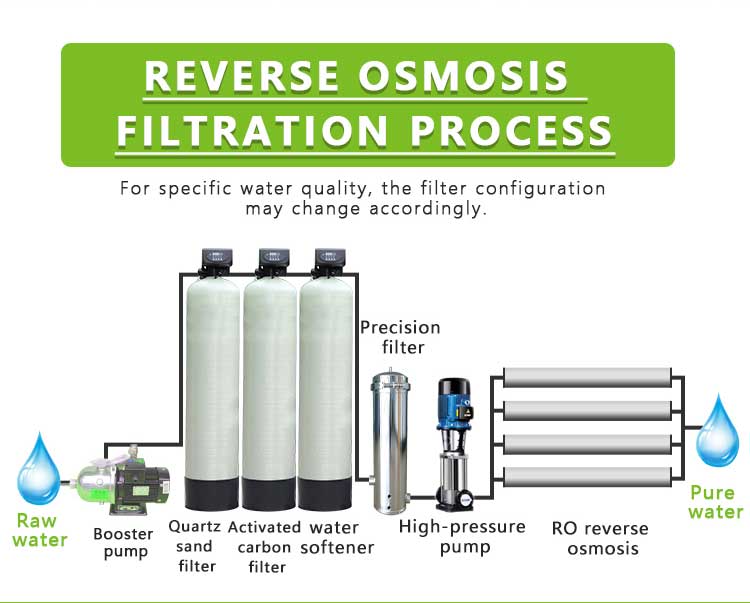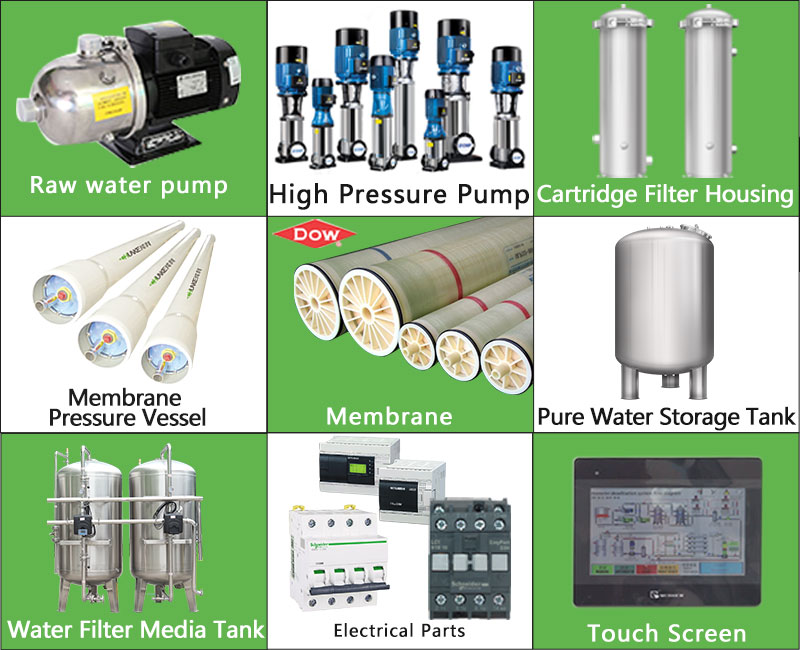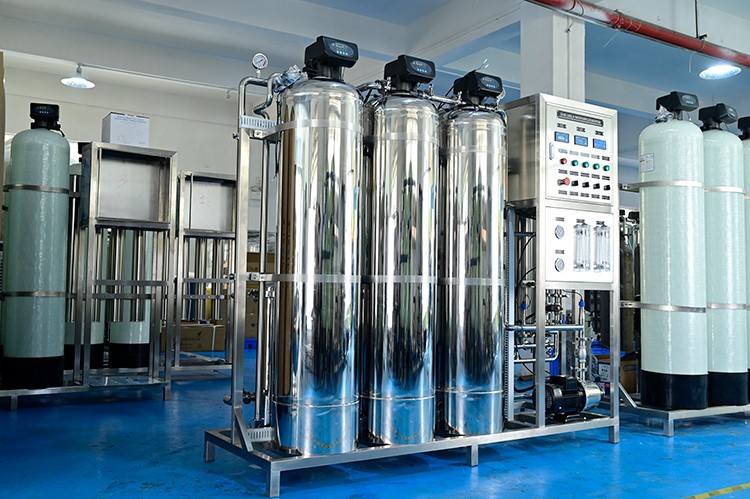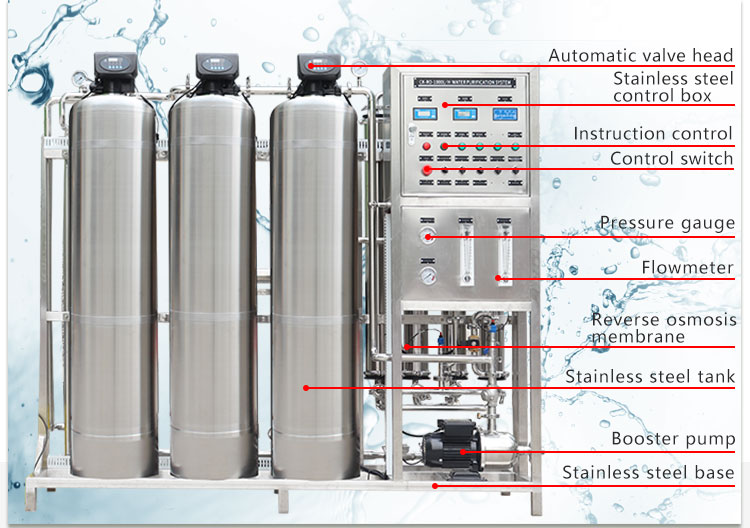How to choose the best reverse osmosis water treatment system?
In today's society that focuses on health and environmental protection, water treatment technology is particularly important. Reverse osmosis (RO) water treatment systems are highly favored for their ability to efficiently filter impurities in water. However, faced with a wide variety of reverse osmosis water treatment systems on the market, how to choose the most suitable product has become the focus of many people's attention.
This article will detail several key parameters that should be considered when choosing a reverse osmosis water treatment system to help consumers make a wise choice.

What is the basic principle of the reverse osmosis system?
Before discussing in depth the parameters for selecting a reverse osmosis water treatment system, it is necessary to understand its working principle. Reverse osmosis is a process that uses a semi-permeable membrane (RO membrane) to remove impurities from water. Water is forced through this membrane by a pressure difference, and pure water molecules pass through the membrane, while most of the dissolved salts, bacteria, viruses, organic matter and other pollutants are retained.
Due to its high efficiency, this technology is widely used in fields such as household drinking water, industrial water treatment and seawater desalination. Compared with other water treatment technologies, reverse osmosis technology can remove about 90% to 99% of dissolved solids in water, making the effluent water extremely pure.

What are the key parameters when selecting a reverse osmosis water treatment system?
Selecting the right reverse osmosis water treatment system is not an easy task. There are significant differences between different systems, so it is necessary to consider a variety of aspects. Here are a few key parameters that cannot be ignored in the selection process.
Water output
Water output refers to the amount of pure water that a reverse osmosis system can produce in a certain period of time, usually in gallons per day (GPD). The water output of a reverse osmosis system for home use is generally between 50 and 100 GPD, while systems for industrial use can reach hundreds or even thousands of GPD.
When selecting a reverse osmosis system, the amount of water output should be determined based on the actual water demand of the home or business. If the daily water demand is large, it is obviously more appropriate to choose a system with a higher water output; conversely, if the daily water demand is small, you can consider a system with a lower water output to avoid waste.
Desalination rate
Desalination rate is the ability of the reverse osmosis system to remove dissolved salts from water, usually expressed as a percentage. The higher the desalination rate, the better the purification effect of the system and the less dissolved solids in the pure water produced. Most high-quality reverse osmosis systems can achieve a desalination rate of more than 90%, and some can even reach 99%.
When purchasing, desalination rate is one of the important indicators to measure system performance. For application scenarios with extremely high water quality requirements, such as laboratory water or high-end drinking water, the higher the desalination rate, the better. In general household use, a desalination rate of more than 90% is usually sufficient to meet the needs.
Filtration level
The filtration level of the reverse osmosis water treatment system usually refers to the number and type of filter elements configured in the system. A complete reverse osmosis system usually contains the following filter elements:
● Pre-filter element: used to remove large particles of impurities and sediments in the water, such as sand, gravel, rust, etc., to protect the RO membrane from being blocked.
● Activated carbon filter element: used to adsorb chlorine, organic matter, odor and some harmful chemicals in water.
● RO membrane: the core part, mainly used to filter dissolved salts, heavy metals, bacteria and viruses in water.
● Post-filter: usually activated carbon filter, used to further improve the taste of water and remove residual impurities.
The more filtration levels the system has, the stronger its ability to remove pollutants in water and the higher the water quality produced. When choosing, the number of filtration levels should be determined according to the complexity of the water quality of the source water. If the water quality of the source water is poor, it is recommended to choose a multi-stage filtration reverse osmosis system to ensure the safety and purity of the output water.
Recovery rate
The recovery rate refers to the proportion of pure water that the reverse osmosis system can convert. Since a part of the concentrated water needs to be discharged during the reverse osmosis process, not all water entering the system will be converted into usable pure water. Generally speaking, the recovery rate of household reverse osmosis systems is between 20% and 50%.
When choosing a reverse osmosis system, the recovery rate is a parameter that needs to be considered. A higher recovery rate means that the system is more water-saving, reduces the waste of water resources, and reduces the burden of drainage treatment. However, it should be noted that too high a recovery rate may cause an increase in the pressure on the RO membrane, thus affecting the service life of the system. Therefore, a balance needs to be found between the recovery rate and the durability of the system.

Working pressure
The working pressure refers to the water pressure required for the reverse osmosis system to operate. Generally, the reverse osmosis system has certain requirements for water pressure, and the standard tap water pressure is generally between 30-100 psi (pounds per square inch). If the water pressure is too low, the system's water output and desalination rate will be affected; if the water pressure is too high, it may damage the system components.
When choosing a reverse osmosis system, it is very necessary to understand the tap water pressure of the home. If the water pressure is insufficient, you can consider installing a booster pump to ensure the normal operation of the system; if the water pressure is too high, you need to install a pressure reducing valve to protect the system.
Water quality detector
The water quality detector is used to monitor the quality of the produced water in real time, usually based on the TDS value (Total Dissolved Solids). The lower the TDS value, the higher the purity of the water. Many high-end reverse osmosis systems are equipped with built-in water quality detectors to help users understand the water quality at any time.
When purchasing a reverse osmosis system, a system with a water quality detector is more recommended. Although this may increase the initial cost of the equipment, it can ensure that every drop of water used by the user is safe and pure, avoiding potential health risks.
Maintenance cost
The maintenance cost of the reverse osmosis system includes the cost of replacing the filter element and membrane, as well as the cleaning and maintenance costs of the system. There may be significant differences in the maintenance costs of reverse osmosis systems of different brands and models. When choosing, you should not only consider the purchase price of the equipment, but also the maintenance costs in subsequent use.
Generally, the replacement frequency of the filter element and membrane depends on the water quality and usage. Generally, the pre-filter element and activated carbon filter element need to be replaced every 6-12 months, and the RO membrane needs to be replaced every 2-3 years. Systems with higher maintenance costs may increase the financial burden of users in long-term use, so the cost-effectiveness of the equipment should be comprehensively considered when purchasing.
Brand and after-sales service
Brand and after-sales service are factors that cannot be ignored when choosing a reverse osmosis system. Well-known brands are usually more reliable in product quality, technical support and after-sales service. As a long-term equipment, the reverse osmosis system can provide users with continuous support and protection with high-quality after-sales service.
Before purchasing, it is recommended to understand the brand's market reputation, after-sales service policy, warranty period and other information. High-quality after-sales service not only includes the convenience of filter element replacement, but also includes quick response and solutions when equipment fails.





